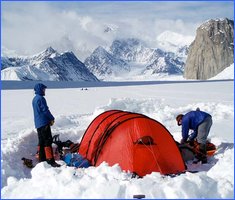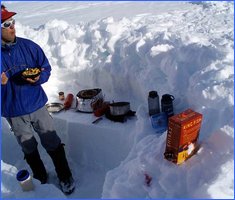Ruth Gorge Climbing Seminar - Denali National Park
After guiding a combined 24 Denali expeditions, we decided it was time to explore other parts of Denali National Park. In the winter of 2006-07 we obtained a permit for guiding in Denali National Park in areas such as the Ruth Gorge, and Little Switzerland. Most serious North American climbers consider the Ruth Gorge to be one of the "must see" climbing destinations in North America. The combination of quick and easy access via Talkeetna bush pilot, and lower altitude climbing allows climbers to pack an Alaska-sized adventure in a relatively short amount of time. The routes here are low enough that we do not need to acclimate prior to climbing and the climbing is centralized allowing us to climb several routes from the same base camp. This lets us to bring in comfortable equipment for base camp, and lighter gear for a big climb if needed. We run this program at a 2:1 ratio in order to provide a higher level of client security and allow us to do as much training and climbing as possible.
Once in the Ruth Gorge we have a wide variety of climbs to choose from, but with first timers we usually focus on nearby Mt. Barrill and Mt. Dickey. When seen from a distance, with Denali as the backdrop Mt. Barrill looks, well, small. Once on the ground and on the route this beautiful and impressive peak quickly reminds us who is in charge as we come to grips with the size of the routes in the Ruth Gorge. Although the climb of Mt. Barrill's Japanese Couloir only takes about 12 hours roundtrip, we need to make sure that we are in the couloir when conditions are cold, and snow stability is good. This often means climbing at night, reaching the summit early in the morning, and making it back to camp in time for a late breakfast. The couloir itself starts at maybe 35° and then slowly get steeper until it is consistent 45+° with short steps of steeper climbing.
On our 2007 climb we climbed together for speed low on the route and then pitched it out for about 6 pitches near the top of the couloir. Once we reach the top of the couloir the climbing is not over as we still have an exposed traverse and 2.5 more pitches of climbing up to 50° left prior to reaching the summit ridge. Once we reach the ridge we are within 20-30 minutes of the summit and 360 views of one of the most beautiful places on the planet. On Mount Barrill we descend the Japanese Couloir using a combination of rappels, and down climbing.
The climb of Mt. Dickey usually follows the climb of Mount Barrill. We break the climb of the West Face of Mt. Dickey into two days, with a camp placed strategically at 747 Pass at 6,370'. The first day is a 4-5 hour affair and takes us up the magnificent valley between Mt. Dickey and Mt. Bradley. This involves climbing up to about 40° and some straight forward, but critical route finding as we sniff our way up a broken glacier. From the pass the climbing progresses well (in good conditions) with short sections up to 40°, eventually leading us to the summit of Mt. Dickey at 9,545'. From the summit we descend back to the 747 camp, pull our camp, and then return to our base camp in the Ruth Gorge.
The rest of our time in the Ruth Gorge will be spent training in the various aspects of glacier mountaineering and alpine climbing with instruction in crevasse rescue, glacier travel, snow and ice climbing, snow and ice anchors, and camp construction as well as work with avalanche beacons and avalanche rescue practice.
Itinerary
This is a sample itinerary, the actual program followed once we reach Talkeetna may vary depending on a variety of factors including weather, mountain conditions, and group strength and motivation. Once on the mountain the order in which we climb selected peaks or even the peaks themselves may be changed once local conditions are determined.Day 1: Meet in Anchorge, AK, take the shuttle to Talkeetna (about 2.5 hours), and spend the afternoon and early evening sorting gear and packing.
Day 2: Fly into the Ruth Gorge (weather permitting) mid-afternoon and establish a base camp on the Ruth Glacier. Generally most of the afternoon and evening is spent building a comfortable base camp.
Day 3: Review crevasse rescue systems, train with avalanche beacons, scout local conditions, and prepare for our first route.
Day 4: Climb Mt. Barrill via the Japanese Couloir.
Day 5: Training day and preparation for overnight climb.
Day 6: Approach West Face of Mt. Dickey and establish camp at 747 Col.
Day 7: Summit Dickey form 747 Col and return to base camp.
Day 8: Extra day for training or descending with evening exit to Talkeetna.
Day 9: Morning spent in Talkeetna drying equipment and repacking for our flights home. Return to Anchorage in late afternoon for flights home in evening.










